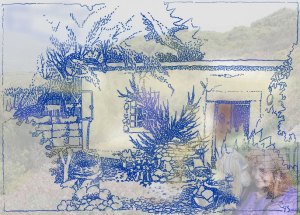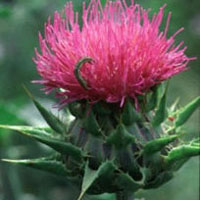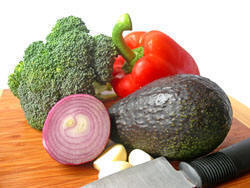
“Throughout eastern Asia the square signifies Earth, the circle refers to Heaven, and the triangle is the potential of Humankind to stand on the Earth and reach toward Heaven – both physically and metaphorically.”
Zen and the Art
of Chinese Medicine
by Steven Alpern, L.Ac.
The scroll of Zen Buddhist monk Sengai (1750-1838) entitled Circle, Triangle, and Square is a concise symbolic expression of classical (Neijing style) Chinese medical thinking. While this brush painting may not be language in the conventional sense, it articulates Sengai’s intention with clarity and power. Practitioners raised and educated in the modern world can benefit from his creative inspiration. We liberate ourselves most effectively from the confines of modern thought, when we grow more conscious of the divergence between our scientific conceptual models and classical oriental thinking.
Each of the three simple geometric figures represents a basic orientation toward being and knowing. Their relation to each other on the scroll presents Sengai’s observation concerning the relationships among their respective modes of thought. Throughout eastern Asia the square signifies Earth, the circle refers to Heaven, and the triangle is the potential of Humankind to stand on the Earth and reach toward Heaven – both physically and metaphorically.
The physical thinking represented by the square is static and structured. The square is the most diffuse among the three figures, thus the least invested as real by Sengai. Physical thinking is governed by the naïve perception that objects displace each other in space. That is, two objects do not occur in the same place at the same time. This principle is then generalized to apply to all qualities and characteristics. It becomes the “principle of the excluded middle” in common logic (formally known as Aristotelian Logic), which creates a world of objects with fixed attributes and qualities. This structured thinking forms the basis of modern scientific thought, and its investigation of nature. Scientific thinking provides a stable cognitive structure (determined by the rules of material implication) that individuals can use to project point of view, and control limited aspects of their environment.
The circle represents the undifferentiated whole that abides either before individuals establish separate points of view or after they transcend them. While the undifferentiated embodied spirit is always there, it is commonly covered over by the individual’s personality. Living in the circle resolves the conflicts that are necessarily engendered by individuality. The circle does not touch the square, and has no stable base from which to project individual point of view. Unconscious projection of interpretations and judgments leads individuals to have attachments that obscure the subtle nature of the world, and their interactions with it. The circle represents instead the ideal of knowing the world separate from point of view, as a dynamic flux of constantly evolving and transforming inter-dependent influences. It allows every perspective because any assertion (or even expression) is understood as merely the projection of individual point of view. Within the “mind of Dao” (the circle) there is no point of view. There is only being and presence.
The triangle represents the embodied spirit’s potential to dynamically transcend the limitations of the square, and progressively approximate the circle. Sengai presents the triangle as barely touching the most diffuse side of the square – the less obvious implications of physical thinking – indicating that it is not embedded within the point of view expressed by the square. The horizontal side of the triangle emerges from the square, and is parallel with its base. This side represents the distilled veracity of the physical point of view supporting the square. The other side touching the square departs in another direction; it represents those aspects of experience not expressed in the square, thus highlighting its limitations in comprehending the fluid dynamic nature of life.
The third side of the triangle (not touching the square) represents the resolution of these diverging points of view. Each is represented by an equally bold stroke (strong investment), but when its extent is realized and the corner is turned toward the other, Sengai withdrew the brush somewhat from the scroll, leaving only a narrow meeting between the two bold ends. His brush painting suggests that resolving diverging points of view is accomplished through perspective – by distancing from both in order to allow the common thread joining them to emerge. This narrow bridge symbolically represents the capacity to resolve opposing points of view by recognizing the contextual validity of each. Individuals can approach knowledge of just what’s so about the point touching the square, and consequently the square itself, by releasing the limitations of individual point of view.
Much of the single stroke of the circle is the most bold and dark of all three figures – to Sengai it is the most real. It begins at the base of the triangle, then immediately includes this bridge within its arc. The circle eventually returns to the base of the triangle, where the stroke becomes somewhat more diffuse. While the loop closes into a circle, it does so without being strictly defined for human perception. The circle interlinks with the triangle around the narrow bridge, which becomes the individual’s point of access into its holistic thinking. The “mind of Dao” cannot reside in any fixed conceptual framework concerning nature. It can only be pursued through an ongoing process of resolving divergent points of view – working the triangle to approach the circle.
Modern science has developed very complex and sophisticated theories of the physical world. Scientists delineate and measure myriad physical parameters, especially with the aid of various sense-enhancing technologies. While this socially agreed upon investigation provides a measure of security, scientific investigations typically fail to discern truths beyond the limits of their physical models. Perhaps Einstein is so widely revered because he stepped outside the conceptual model of his time, and explored genuinely new ways of seeing and understanding phenomena. This is indeed rare in the scientific world!
Scientists generally eliminate experiential phenomena as subjective, and give precedence to “objective” measurements. They remain focused on statements of physical status, rather than discerning the fluid dynamics of evolving process, which is based in individual responsiveness rather than uniform movements. The physical bias of scientific thinking seeks direct, predictable, and reproducible relationships between causes and effects. It reduces the complexity of systems by focusing only on parameters that can be physically defined and measured. This process results in mechanistic models of physical reality that prioritize single (proximal) causes and the material implications they engender, rather than exploring the variety of contributing causes that generate individual variations.
The “experimental method” for investigating the world falls short of being truly empirical, because it projects the physical perspective of the square. Only the circle, which accepts all possibilities, is truly empirical. Yet, the physical theories of the square appeal to many because they provide conceptual models that explain (and can predict) certain phenomena. While this may be an expedient method for controlling a limited scope of the environment (in space and/or time), investment in the mechanistic model blocks a deeper understanding of the complex web of causation that characterizes individual situations.
Physical theories typically evolve in response to conflicting data. Gradually, scientists recognize the limitations and/or inaccuracies introduced by both their explicit assumptions and unconscious projections. Integrating certain considerations from the other side of the triangle can refine the conceptual model projected by the individual’s point of view. But, a box remains a box. The increased sensitivity of the model may help one control certain aspects of the environment, but it does not capture the potential of individually differentiating the blocks to vital process that create distress, and the embodied spirit’s need to express symptoms.
The application of scientific thinking to issues of health has pervasive implications. It impacts both how doctors understand the nature of various diseases, and the practical (clinical) approaches developed to address them. Scientific medicine absorbed its purpose from the common emotional urge to see disease and suffering as afflictions, rather that a natural result of life. This bias has created a theory of external (physical) etiology, which relieves individuals of responsibility for both the development and resolution of disease. The clinical emphasis of modern medicine is controlling the expression of disease, rather than resolving the roots of its dynamic process within each individual’s life (which cannot be standardized into protocols). Focus narrows to controlling symptoms (often through suppression), rather than discerning and disentangling the factors creating and sustaining the individual’s blocks.
There are many specific topics within the various scientific fields related to health care that demonstrate the implications of physical bias, especially in clinical implementation. Relative to:
· Nutrition and Herbs: There is far more emphasis among most experts on the amounts of specific nutrients and “active ingredients” (easily measurable and external), rather that on the individual’s ability to utilize them (internal and not easily quantified or measured). Within the scientific model, attempts to understand and evaluate life as a vital process led to the refinement of overly simplistic chemical models into more sensitive biochemical ones. This led to the idea of “bio-available nutrients,” which represents a significant improvement over the earlier standard. Yet, it remains a uniform (external) measure rather than one that differentiates individual (internal) capacity to utilize nutrients and “active ingredients.” The Chinese medical ideas of food, qi and blood stagnation address some of an individual’s specific blocks in resolving material that has been internalized. Individuals may struggle with many different blocks and/or insufficiencies that undermine their ability to process physical and experiential inputs into smoothly flowing qi and blood. They may need a wide variety of therapies to stimulate them to release, transform, dissolve, or vaporize their impacted attachments. The effects of neither foods nor herbs can be analyzed down to nutrients or “active ingredients.” Rather, the impact of their qi on an individual person’s qi is generally discussed in experiential terms: flavor, nature (temperature), and channels resonance. Such metrics help practitioners individualize treatments to stimulate and facilitate a patient’s intrinsic responsiveness rather than attempting to generically control disease expression.
· Infectious Disease: There is nearly exclusive emphasis upon various microbes as the (proximal, physical, and measurable) causative factors, and nearly none on the individual’s internal ecology as a terrain for the particular microbes. This idea includes but is not limited to the effectiveness of immune response. Therapeutic focus is directed toward immobilizing the reproduction of microbes (physically measurable), without considering the vitality and effectiveness of the individual mechanisms that expel them and/or impede their penetration (not measurable). Therapy is directed toward measurably controlling the external environment, and considered complete when the proliferation of microbes is rendered inert. Little attention is focused on the impact therapy has had upon the terrain – the integrity of the individual’s physiological homeostasis (which is difficult to measure), unless it has been sufficiently deranged to support another infestation, such as candida in the gut. The Wen Bing (Warm Diseases) School of Chinese medicine differentiates three terrains, each with its distinctive nature, typical paths of development within individuals, and characteristic paths of expulsion and resolution. It provides guidance for therapeutic intervention in people struggling with chronic or recurrent viral (wind-cold), bacterial (wind-heat), or fungal (wind-damp) infections.
· Osteo-arthritis: There is nearly exclusive emphasis upon inflammation as the (proximal) cause of pain and the growth of osteophytes. There is little discourse concerning either habituated muscle contractures, which provide a stable platform for the growth of osteophytes, or as a contributing cause to strain, which precipitates inflammation. Neither is there much discussion of nutrition, and even emotional patterns, as contributing causes of a biochemical terrain supporting the growth of osteophytes and/or a particularly strong (or poorly controlled) inflammatory response. The medical approach to clinical management of people with osteo-arthritis is directed toward controlling the inflammation and pain, rather than stimulating the individual to change his or her (internal and individual) factors supporting habituated contractures. While many physicians suggest exercise for patients with osteoarthritis, there is little emphasis upon the quality of movement. Specifically, there is little focus on devising and teaching movements to release the individual’s habituated contractures, which precipitate and sustain the development of osteophytes. There are many such systems of therapeutic movement (Qigong, T’ai Chi, Daoyin) inspired by Chinese medical theories, which facilitate movement and can eliminate or dramatically reduce pain and physical restrictions. There are several other systems of exercise that are equally valuable in stimulating the flow of qi, which derive from other medical traditions such as yoga from Ayur-veda.
While the historical and philosophical roots of classical Chinese medicine lay deep in the shadows of ancient China, the thinking process of the triangle – working the triangle to approach the circle – remains vitally important. One can work ideas rooted in modern science with that thinking process to discover pervasive physical bias. Individuals can learn to observe and discriminate the unconscious projection of point of view, and release their rigid models for understanding the physical world, which each person must develop in order to survive. We can learn to release how we analyze what we know, and accept fluid interpretations of what we sense. This can help practitioners develop true intuition, which is based in calm and quiet acceptance of circumstances, events, and reactions.
The language of modern science can make many subtle differentiations, if those using it remain sensitive to its inherent physical bias. People with any disease process can be examined with a focus on the internal factors that generate and support dysfunction, rather than simply focusing on precise physical descriptions. Patients who learn to disentangle from the conflicts that generate their blocks can reduce their dependence on reactive attempts to control symptomatic expression.
Some modern practitioners of Chinese medicine seek the certainty of a fixed conceptual model. Rather than including the wide variety of historical theories and having to “work the triangle” to differentiate individual cases, modern Chinese medical doctrine provides a single explanation for many symptoms and signs. Practitioners are taught to classify the manifestations of dysfunction into symptom-sign complexes, and develop therapeutic strategies aimed directly at managing them. This clinical model is familiar to people trained in physical (scientific) thinking.
Rather than classifying the manifestations of imbalanced function, Neijing style practitioners seek to identify clearly the individual’s specific blocks, and his or her struggle to maintain life. The classic texts of Neijing (Suwen and Lingshu) use the dynamic interactions among the five sets of channels and vessels (sinews, luo, primaries, divergent/distinct, and extraordinary) to facilitate the embodied spirit’s intrinsic process, rather than just classifying their manifestations into syndromes of imbalance in the zangfu (vital and hollow organs) and trying to manage them with the primary channels alone.
For instance, modern TCM subscribes to the ideas of Chao Yuanfang concerning the source and generation of phlegm. Chao was an Imperial physician during the Sui Dynasty (581-618), who focused on the proximal cause of phlegm as inadequate transformation and transportation of food essence by the spleen/pancreas, which collects in the lungs according to the “normal” physiology of generating post-natal qi. While this is an important source of phlegm, many other ideas about it have been used and validated during the long history of Chinese medicine:
· liver qi stagnation, which allows for the stagnation of fluids and compresses them into phlegm; continued impulse (yang) generates heat (hot-phlegm), and can degenerate into wind (wind-phlegm). The etiology of these was first clearly delineated by Zhang Zihe (1150-1228).
· de-vitalization of kidney essence (Kidney yang deficiency), which directly degenerates into phlegm. Blocking or withdrawal of impulse allows cold-phlegm to collect, and the individual’s failure to control fluids (generally exacerbated by diet) generates damp-phlegm. While these names would not be developed for several hundred years until Tang era (618-907) doctors focused on fluids and phlegm as primary pathogenic factors, Zhang Zhongjing certainly recognized the basic dynamic of these etiologies in herbal formulas such as Xiao Qing Long Tang (Minor Blue Dragon Decoction) in Shang Han Lun. Later authors, such as Zhang Jingyue (1563-1640), developed further the idea that “life is yang,” and focused on preserving it.
· exhaustion of kidney essence (Kidney yin deficiency), which generates phlegm as a distorted attempt to preserve essential yin – phlegm as a response. Zhu Danxi (1281-1358) focused on essential yin as the foundation of life.
· lack of willingness by the embodied spirit to see (Heart qi) its experience as it is, which is the cognitive basis of denial. Denial is somatized into phlegm by the embodied spirit – to make it dormant. This allows the individual to internalize “new” inputs to process and thereby continue generating post-natal qi.
The clinical ideal of classical Chinese medicine considers each treatment a unique creative response to an individual patient. The immediate focus stimulates his or her intrinsic responsiveness (wei) and/or capacity to internalize experience (ying). The purpose of acupuncture (and other Chinese medical therapies) is facilitating the individual’s release of habituated holding patterns, which accumulate to restrict movement and create various distortions of the individual’s interaction with the environment. Eventually, these distorted interactions derange physiological process and create disease. Resolving these disturbances to vital process (qi) allows disease resolution, rather than having to settle for its management.
Instead of releasing their points of view and resolving recurrent conflicts and struggles, many individuals develop various adaptive and compensatory strategies to accommodate them. These can be probed with therapies, but regardless of how insightful the conception and implementation of a therapeutic strategy, the patient must be willing to release habituated patterns of interpretation and reaction. Therapy does not directly create healing, but it can stimulate profound transformations of vital process (qi), allowing individuals to grow out of the disease(s) they host through distorted physiological process.
A practitioner who uses the wide variety of historical ideas of Chinese medicine can enrich his or her contemporary practice with a rich framework for making differentiations, and determining therapeutic strategies. There is no limit to the variety of disease manifestations that have been discussed and treated during the history of Chinese medicine. While the modern world presents new stressors to challenge the embodied spirit, there are not new ways for it to be overwhelmed and fail to sustain individual life.
Therapeutic results beyond those predicted (or even accounted for) by the physical theories of “scientific medicine” are available when both the practitioner and “patient” are willing to go “outside the box” – the square – to engage the intrinsic wisdom of the embodied spirit. Many treatments stimulate the individual’s intrinsic responsiveness to expel stagnating factors, and thus liberate the “patient’s” vitality to focus on supporting life process. Treatment strategies are found by the practitioner listening to the embodied spirit’s expression of distress, and facilitating its intrinsic movement to live.
Therapeutic work inspired by the profound mysteries of life cannot be standardized into protocols. It arises from identifying and stimulating release of an individual’s blocks and impacted struggles. Healing ensues when “patients” allow their whole beings to engage experience in an open and focused way to support vital function. There is no limit to the awesome potential of the embodied spirit!
Read Full Post »









